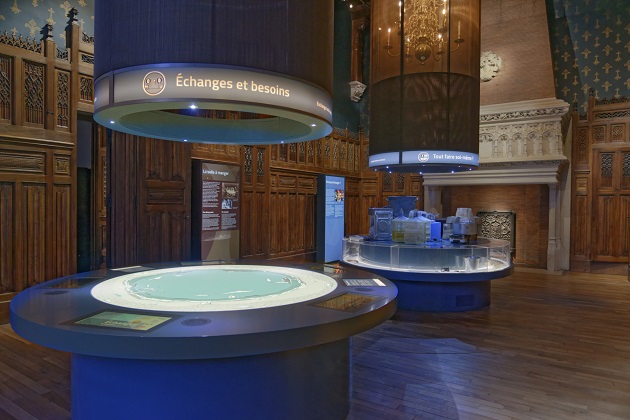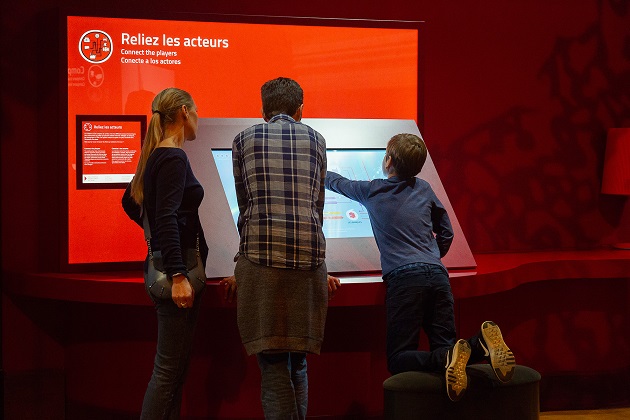The semi-independent visit allows pupils to explore the permanent exhibition in small groups, with a specially designed questionnaire. Citéco’s mediators will be there to meet them throughout their visit to help them understand the route and theme of their visit.
All the themes are adapted to the first year general and technological lycée SES sylabus and to the second third year general stream lycée SES syllabus, as well as to the second and third year lycée STMG syllabus.
When booking, teachers select a visit route from among those offered. Once the booking has been confirmed, teachers will receive an educational pack and questionnaires for pupils (to be printed before the visit) via email to help them plan their visit to the Cité de l’Économie.
Semi-independent visits are only offered to SES (economic and social sciences) and STMG (management sciences and technologies) lycée students.
Discover all our semi-independent visits!
Published on 28 October 2019. Updated on 14 October 2022
Guided Tours (1h)
- School groups: €5 / student
- University students: €6 / student
- Adults: €12 / participant
Includes admission to the permanent exhibition and a guided tour led by a Citéco cultural mediator.
Workshop Tours (1h30)
- School groups: €6 / student
- University students: €7 / student
- Adults: €12 / participant
Includes admission to the permanent exhibition and a workshop tour led by a Citéco cultural mediator.
Semi-Guided Tours (1h) - Only in French
(For high schools – Economic and Social Sciences STMG)
- School groups: €4 / student
Includes admission to the permanent exhibition, presence of cultural mediators in the exhibition areas, and activity sheets sent in digital format (to be printed in sufficient number for all students).
Self-Guided Tours
- School groups: €3 / student
- University students: €5 / student
- Adults: €10 / participant
Includes admission to the permanent exhibition.
Tour guide speaking rights are exempt from additional fees.
Free Admission
- Primary schools
- After-school programs
- Middle schools in REP/REP+ networks and high schools located in priority city areas, thanks to CAPZA sponsorship
- 8th grade classes participating in the EDUCFI passport program
Visitors with Disabilities
- €3 / participant (all tour types)
- Free admission for all accompanying persons
Rules for Accompanying Adults
- Kindergarten: 1 free admission for every 5 paid entries
- Elementary school: 1 free admission for every 12 paid entries
- Secondary school: 1 free admission for every 15 paid entries
- Adult groups: 1 free admission per group
- Visitors with disabilities and social care groups: Free admission for all accompanying persons
Published on 22 October 2019. Updated on 24 July 2025
The Cité de l’Économie welcomes all groups of at least 10 participants.
Visits are organised according to specific time slots and a specific schedule.
The Cité de l’Économie will open its doors exclusively for groups in the morning!
Bookings are required up to six weeks before the day of the visit*. Payment must be made at least one month before the start of the visit.
For your booking request, please fill in the group booking form. No requests by email or telephone can be processed.
NB: The completion of this form does not constitute an option or a pre-booking. As soon as we receive your booking request, your visit will be recorded and processed by our teams.
*excluding specific operations
Published on 19 October 2022. Updated on 02 March 2023
To help you plan your, you will find visitor booklets in French, English, Spanish, German, Italian, Russian and Arabic.
Education pack
If you would like to plan your visit, find out about all the visit options and learn about the different sections of the Cité de l’Économie’s permanent exhibition, you will find all this information in our educational pack.
Educational resources
To help you plan your visit, we offer online educational resources.
Offers for teachers
To help you discover the spaces, permanent collections, temporary exhibitions, activities and educational resources, we offer regular events designed for teachers. Sign up for our newsletter to receive all our news!
Published on 22 October 2019. Updated on 28 October 2022
The Cité de l’économie welcomes you!
Thursday 9 December : Bookings open for group visits until 28 August 2022.
Step 1 : Take note of the visit options:
-
Semi-independent visit (only for SES (economic and social sciences) and STMG (management sciences and technologies) lycée students)
Step 2 : Book your visit by filling in the online booking form.
Group visits take place from Tuesday to Sunday (depending on available slots)
The Cité de l’Économie opens its doors exclusively for groups in the morning!
Step 3: You will receive an email confirmation.
As soon as we receive your payment, our teams will send you details to plan your visit.
Bookings are processed by priority of the visit date. Our bookings department is at your disposal for any further information.
Published on 22 October 2019. Updated on 12 January 2023
No more unclear terms and lengthy explanations: to ensure that you “Got it?”, Citéco offers you the opportunity to learn about the economy in a simple and intuitive way! Ready for an adventure? Settle in comfortably, press “play” and have a coffee while you get to know Virgile, Lauren, Lisa and Medhi, our museum’s budding economists.
1/ Corporate governance
How to encourage company managers to make concerted and transparent decisions - or prevent Virgile from unilaterally ordering Lisa to place the drink order?
The answer is a simple notion: “corporate governance”! Take our quiz to test your knowledge!
2/ Multinational companies
Do you want to know why your microwave is stamped “Made in China” and why your brand-new mobile was shipped from India? So do Lisa, Lauren, Mehdi and Virgile, who are discussing multinational companies in this new episode of “Got it?”.
3/ The social and solidarity economy
Does “Economy” always rhyme with “search for profit”? Lauren, Mehdi, Lisa and Virgile discuss their views in episode 3 of “Got it?”!.
4/ Moral hazard
Would Virgile practice an extreme sport if he knew he was not insured? Would banks take risks if they had no support from the State? It’s highly doubtful if we are to believe the notion of moral hazard which our “Got it?” protagonists are discussing in this new episode!
5/ Unemployment
Unemployment is a hot topic, but what do we actually know about it? Who is unemployed and who isn’t? Can we be voluntarily unemployed? In and out of crises, is unemployment always present? Can we achieve a 0% unemployment rate? All the answers to these questions are in this new episode of “Got it?”. Take our quiz to test your knowledge!
6/ The human development index
The Gross Domestic Product (GDP) evaluates a country’s economic situation, but it is not the only indicator that measures a State’s development: the Human Development Index focuses on a country’s social and qualitative development. But what actually does it take account of? Is it enough to determine a population’s quality of life? In this sixth episode, our budding economists will answer all your questions on the HDI and its many facets.
7/ Social protection
In this new episode, Lisa, Lauren, Mehdi and Virgile are discussing social protection! Social protection refers to all collective providence mechanisms put in place by the State, which provide financial protection against the consequences of social risks, i.e., situations that can cause a loss of income or an increase in expenses (old age, disease, invalidity) ... But how exactly do these mechanisms work? Our budding economists will give you the lowdown in under 4 minutes!
8/ Common goods
“A common good is a very particular, but hugely interesting notion!” After listening to explanations from Lisa, Lauren, Mehdi and Virgile, you’ll know all there is to know about common goods!
9/ The World Trade Organization
You no longer have an excuse for not understanding anything about economics with our new "Got it?" episode on the World Trade Organization! Virgil, Lauren, Lisa and Medhi share their tips for capturing everything about the economy
10/ Externalities
Positive and negative externalities, why? In this new episode of "Tas Capté", our budding economists will decipher the effects of externalities on the well-being of economic agents!
11/ The prisoner’s dilemma
We missed our budding economists! In this episode of "T’as Capté", they will discuss the concept of the prisoner’s dilemma. You’ll understand why, when there are several players in a market, it’s more efficient for them to communicate and cooperate than to go it alone!
12/ Emission allowance markets
In this new episode of "T’as Capté", Virgil, Lauren, Lisa and Medhi explain to us what emission allowance markets really are. Find out how these spaces in which one can trade rights to pollute work. So what are the benefits and limitations of these markets?
13/ Minimum wage
In this new episode of "T’as capté ?", Lauren has found a student job and will be earning the famous SMIC! Our favorite economists will explain how this minimum wage, created in 1950, works.
14/ The speculative bubbles
Lauren’s apartment-hunting is no easy task! To explain the astonishingly high property prices, our economists look at the subject of speculative bubbles. Are you familiar with the Black Thursday of 1929?
15/ The comparatives and absolute advantages
Today, Lauren finally finished knitting her beanie ?
But Virgil and the gang are wondering if it’s more beneficial for Lauren to make her beanie herself, if we take into account the time spent making it and the quality of it, or to buy it directly ? Let’s find out with them the comparative and absolute advantages!
16/ The systemic shock
The subprime crisis of 2008, do you know it? Banks, failures and financial risks, Virgil and his gang explain to you today the systemic shocks!
17/ Value chains
Do you know the value chains? Virgil, Lauren, Lisa and Medhi explain it all to you!
18/ Purchasing power
Times are hard for Lisa, she’s working harder than before and still has the same income. Isn’t she losing purchasing power? In this new episode, our apprentice economists join forces to understand the famous "purchasing power" and help Lisa!
19/ Competitiveness
The "T’as capté ?" team talks to us today about competition, cost, quality... in short, competitiveness! What about you, price or non-price competitiveness? Where does France rank in the world in terms of competitiveness? The answer in episode 19!
20/ The Recession
Lisa wonders about the current situation in France: recession or not? In this new episode of "T’as capté ?" learn to understand what a recession is, what causes it, and the measures in place to overcome it.
21/ The Creative Destruction
Artificial intelligence and new technologies are an outstanding example of creative destruction in progress. These are highly promising innovations, but they can also be frightening, as they could destroy a good number of professions. This new"T’as Capté" video is an opportunity to take a closer look at this interesting economic model, first thought up by Joseph Schumpeter !
22/ Protectionism
What is protectionism? What are its advantages? Its disadvantages? What does it involve? All the answers to these questions are in this episode of "T’as Capté"!
23/ Productivity
Lauren wonders: how can I be more productive? Is it just a matter of working harder? Or is it just a matter of getting the right equipment? With this new episode of "T’as capté", you’ll have a perfect grasp of the concept of productivity!
24/ Adverse selection
Medhi is depressed, having just invested in a second-hand bike that turns out to be defective... That doesn’t encourage his friends to buy second-hand!
25/ The non-market production
Many goods and services, including culture, are available at prices below production costs. This is known as non-market productivity! But who finances these non-market products? That’s what we’re going to find out in this new episode of T’as capté!
Published on 30 December 2020. Updated on 13 June 2024
Citéco is open from Tuesday to Sunday, from 2 p.m. to 6 p.m., and until 7 p.m. on Saturdays.
Late-night opening: every first Thursday of the month, from 6 p.m. to 10 p.m. (from October to June).
During school holidays (Zone C), opening hours are extended: from 10 a.m. to 6 p.m., and until 7 p.m. on Saturdays.
The museum will be closed for annual maintenance from August 19 to 31, 2025.
Additional closing days: May 1st, December 25th, and January 1st (early closure at 4 p.m. on December 24th and 31st).
Last admission: 1 hour before closing time
Exhibition rooms start closing: 15 minutes before closing time
Strollers are not allowed in the exhibition areas. Baby carriers, suitable from birth, are available free of charge to ensure your comfort during the visit. Scooters and skateboards are not permitted inside the building.
Published on 02 March 2020. Updated on 17 July 2025
Together, let’s share the keys to understanding the economy!
Citéco is an association that offers a new type of cultural site
At the heart of Plaine Monceau, in a fully restored Renaissance Revival historical monument, Citéco is the first European Museum focused on economy. It takes visitors on a discovery of economic terms and issues in an interactive and fun way, through a permanent exhibition spread across 2400m2 and divided into six sequences: Exchanges, Players, Markets, Crises, Regulations, Treasures.
Designed in the image of an actual “city”, this living space also offers encounters, debates, entertainment and cultural activities all year round.
Do you represent a company ? |
Are you an association, school or public body |
|
| that wants to support the Cité de l’Économie? | that wants to help the Cité de l’Économie? | |
 |
 |
|
Get in touch
Julie Baron Benacquista, in charge of patronages, partnerships and business clients: julie.baron@citeco.fr We’d love to work together |
||
Citéco thanks its patrons and partners |
Published on 10 July 2019. Updated on 29 April 2022
Welcome to the Cité de l’Économie, housed in an extraordinary location: the Hôtel Gaillard, a genuine 19th-century urban château, listed as a historic monument. Step through its doors and explore exceptional architectural heritage, where history, art, and economics come together.
A fairy-tale setting in the 17th arrondissement
You can’t miss it! With its red brick walls, slender turrets, and slate roofs, the Hôtel Gaillard stands out from the surrounding stone buildings. Inspired by Renaissance architecture, this château was the brainchild of banker Émile Gaillard, a passionate art collector who wanted a home worthy of his collection.
An elegant district, an exceptional residence
In 1878, Émile Gaillard commissioned the construction of his private mansion near the Plaine Monceau, in a rapidly developing neighborhood. He had three buildings erected around a central courtyard, creating a harmonious ensemble. The main residence proudly displays its façade, not hidden behind a gate as was often the custom. The goal: to impress from the very first glance.
Medieval architecture: a 19th-century passion
In the 19th century, Gothic and Renaissance revivals were all the rage. Émile Gaillard fully embraced this trend: his château embodied the elegance of the past and the spirit of innovation associated with the Renaissance. This taste crossed borders too — in the United States, homes like the Biltmore Estate echoed the same “castle” style.
A home for living, entertaining... and exhibiting art
The Hôtel Gaillard was designed to house a family, host lavish receptions, and showcase a collection of medieval and Renaissance artworks. Its interiors are filled with refined decor: salons, galleries, carved woodwork, tapestries, stained glass... Each floor had a specific function, from the ground floor to the eldest son’s apartment on the top level.
A showcase of remarkable craftsmanship
The Hôtel Gaillard highlights rare artisanal techniques: intricately carved woodwork, colorful stained glass, enameled ceramics... Émile Gaillard collaborated with the finest craftsmen of his time, including some who worked on restoring the Château de Blois. The result? A sumptuous residence that blends history and artistic creation.
A neo-Renaissance château designed by Jules Février
Built between 1878 and 1884, the mansion draws inspiration from the châteaux of Blois and Gien, jewels of French Renaissance architecture. Its style evokes grand royal residences, with meticulous attention to architectural detail. Architect Jules Février relied on prestigious references and exceptional craftsmanship to bring this aesthete’s dream to life.
A second life as a bank: the Banque de France moves in
In 1919, the Hôtel Gaillard was purchased by the Banque de France to house a branch. Architect Alphonse Defrasse was tasked with the renovations, respecting the spirit of the place while adapting the spaces for their new use. The result: a successful blend of heritage and modern functionality.
The Defrasse Hall: architectural feat and security marvel
In the inner courtyard, Defrasse created a spectacular public hall topped with skylights and a monumental wooden framework. Below ground, the vault room impresses with its cutting-edge security system: reinforced door, water-filled moat, sliding floor… A scene straight out of a spy movie!
A respectful and grand transformation
Despite its new function, the original decor was preserved, woodwork restored, and Gothic motifs subtly reinterpreted. Even the counters and furniture were custom-made in Renaissance style. As a bank, the Hôtel Gaillard retained its breathtaking grandeur.
Published on 22 April 2019. Updated on 18 June 2025

